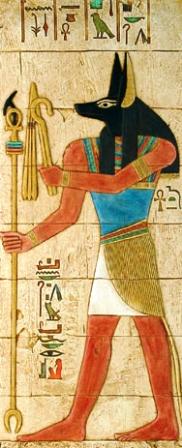
| The Ankh | 
|
|
Ancient Egyptian Gods and Goddesses for kids - Ankh The history of ancient Egypt and the significance of the Ankh |
|
Ankh
Discover the history and religious beliefs surrounding the 'Ankh' was one of the most important Egyptian Symbols seen in images and pictures of ancient Egypt. The 'Ankh', which was also known as key of life, was depicted as a "cross with a handle" that represented eternal life. The 'Ankh' was often depicted with ancient Egyptian Pharaohs and the images and hieroglyphs of ancient Egyptian gods and goddesses. It was held in the hands of the gods as a symbol of their power to give life or take it away. The symbol of the ankh meant “life” and was often used as an amulet, as a symbolic representation of both physical and eternal life. The Ankh symbolized life, immortality and reincarnation. |
|
Facts about the ancient Egyptian Ankh
The Ankh was an ancient Egyptian hieroglyph and its icon is depicted in art, artefacts, relics. Examples of the icon can be found in the tombs, temples and manuscripts of the ancient Egyptians. The gods were endowed with divine, eternal life and could bestow it upon the mortals. Look at the top of the page, and the other images contained in this, and other articles on ancient Egypt, and you will see many depictions of the Ankh. 
The Ankh Fact File |
Name: |
The Ankh was also known in Latin as 'crux ansata' and the "eyed" cross, the Key of the Nile
| | Description & Definition: | Description & Definition: It is described as a cross with a handle
| | Materials: | The materials used to make a Ankh varied but could be constructed from stone, wood, ebony, ivory or precious metals such as gold, and less frequently silver
| | Significance: | The sacred icon was depicted in royal funerary scenes and reinforced the close connection between the pharaohs and the gods in whose name he ruled and to whom he returned after death
| | Symbol: | The Ankh was was one of the most potent symbols of ancient Egypt symbolizing physical life, eternal life, immortality and reincarnation
| | Fetish: | The Ankh was believed to be a fetish, an object that was believed to embody magical powers and offer magical protection
|
|
|
Facts about the Ankh in Egyptian Mythology and History
Discover interesting information and research facts about the Ankh, the iconic Egyptian symbol. The facts about the Ankh provides a list detailing fascinating additional info to increase your knowledge about the Ankh in Egyptian Mythology and history. Facts about the Ankh from Mythology and Egyptian History |
Fact 1: |
It was associated with life after death and the dead were sometimes referred to as "ankhu"
| | Fact 2: | A term for a sarcophagus was neb-ankh which meant possessor of life
| | Fact 3: | Mirrors were used for purposes of divination in Ancient Egypt as life and death were believed to mirror each other. Many ancient Egyptian mirrors were therefore shaped in the form of an ankh sign.
| | Fact 4: | The sign of the ankh was also used to symbolize water in ceremonies and rituals relating to purification
| | Fact 5: | Many depictions of the icon showed Egyptian gods and goddesses holding the ankh in front of the face of a Pharaoh to symbolize the breath of eternal life.
| | Fact 6: | Theories on the origins of this famous icon are numerous and range from sexual symbolism to the common sandal strap
| | Fact 7: | Early examples of the ankh show the end vertical sections separated
| Facts about the Ankh from Mythology and Egyptian History |
|
|
Ankh- Interesting research information and Facts about the Egyptian Ankh
- The sacred regalia of ancient Egyptians
- History and Egyptian Mythology associated with Ankh
- Facts and information about the gods and deities of of classical Egypt for schools, research and kids
- Pictures, Description and description for kids
|
| | |
|
The Ankh - Symbol of Life
The Ankh was a symbol of physical life, eternal life, immortality and reincarnation and formed part of the part of the regalia depicted in ancient Egyptian funeral scenes and held by various Gods and Goddesses such as Anubis, Osiris, Ra, Isis, Ptah, Sobek, Tefnut and Hathor and the judge deities of the Underworld. The significance is that they command the powers of life and death and that they are immortal. The picture depicts Anubis, the god of the dead, with various symbols of power and authority including the Ankh. The ankh is commonly displayed in association with the Was Sceptre and the djed column. - The Was Sceptre: The Was Sceptre was a long rod or staff that symbolized divine power and was an emblem of authority
- The Djed Pillar: The Djed column was a pillar-like symbol used in in hieroglyphics representing stability
The Ankh - Symbolism of the Icon
The sign or icon was symbolic of: - The Sunrise: The loop represented the Sun rising above the horizon, which is represented by the crossbar
- The vertical section, below the crossbar, symbolized the path of the sun

| 
|
|
|
|
|